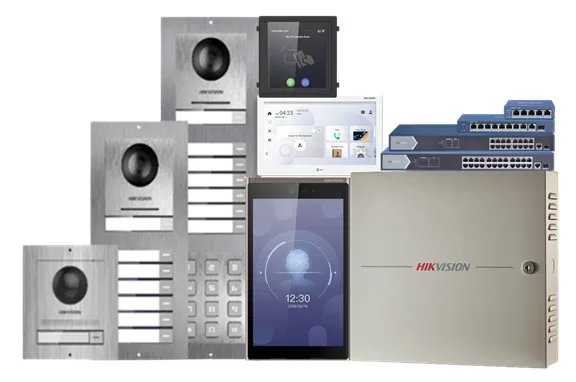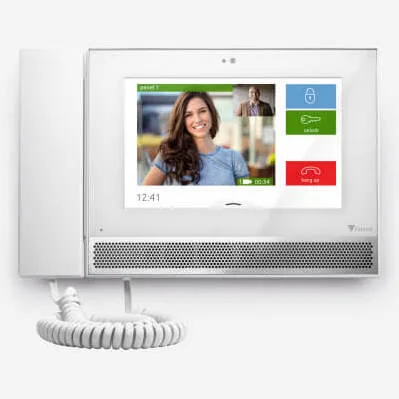Essential Guide to Access Control Installation for Secure Environments
Introduction to Access Control System Installation
Access control installations are a critical step in securing commercial properties and restricting access to authorized personnel.
A well-designed access control system can help prevent security breaches and protect valuable assets.
Access control systems can be integrated with other security systems, such as video surveillance and alarm systems, to provide a comprehensive security solution.
Installing access control systems requires careful consideration of factors such as door entry systems, door locks, electric locks, and intercom systems to control access efficiently.
Access control system installation can be complex, so it’s essential to work with experienced access control installers.

Choosing the Best Access Control System
The best commercial access control system for a commercial property depends on various factors, including the number of users, entry points, and security requirements.
Commercial access control systems, such as biometric systems like facial recognition and fingerprint recognition, offer advanced security features.
Door entry systems with keypad systems or access cards can provide an additional layer of security and can be installed with a few different types of electronic locks.
Wireless locks and radio frequency identification (RFID) systems can offer convenience and flexibility.
It’s essential to consider the installation and management of a door access control system, as well as potential security breaches, when selecting an access control system.

Access Control System Components
- A typical access control system consists of door readers, door controllers, and access control management software.
- Door readers can include keypad systems, access cards, or biometric systems.
- Door controllers manage access and can be integrated with other security systems.
- Access control management software provides a centralized platform for managing user credentials and access levels.
- Electric door locks and external power supply systems are also critical components of an access control system.

Access Control System Components
Electric door locks and external power supply systems are also critical components of an access control system.
A typical access control system consists of door readers, door controllers, and access control management software.
Door readers can include keypad systems, access cards, or biometric systems.
Door controllers manage access and can be integrated with other security systems.
Access control management software provides a centralized platform for managing user credentials and access levels.
Installation Considerations for Commercial Properties
When installing access control systems in commercial properties, it’s essential to consider factors such as life safety code and fire alarm code compliance.
Access control systems must be designed to prevent unauthorized access while allowing authorised personnel to gain access.
The installation process should include careful consideration of door access control installation, door locks, and electric locks. Ensuring the correct fit and alignment of electric strikes with the strike on the door jamb is crucial for the functionality of electric locks.
It’s also essential to ensure that the access control system is integrated with other security systems, such as video surveillance and alarm systems.
A comprehensive security solution should include multiple layers of security, including access control, surveillance, and alarm systems.
Security Considerations for Commercial Property
When it comes to securing a commercial property, there are several key considerations to keep in mind. One of the most important is the installation of a comprehensive access control system, which includes a door entry system as a critical component. This can include door entry systems, biometric access control systems, and other security measures to prevent unauthorized access. A well-designed access control system can help to protect employees, customers, and assets, while also providing a secure and convenient way to manage entry and exit points.
Access control systems are essential for managing who can gain access to different areas within a commercial property. By implementing door entry systems and biometric access control systems, businesses can ensure that only authorized personnel can enter sensitive areas. This not only enhances security but also helps in maintaining a record of who accessed which area and when.
Moreover, integrating these systems with other security measures, such as surveillance cameras and alarm systems, can provide a layered security approach. This integration allows for real-time monitoring and quick response to any security breaches, ensuring that the property remains secure at all times.
In addition to security, access control systems offer convenience. Traditional keys can be easily lost or duplicated, posing a significant security risk. In contrast, modern access control systems use electronic locks, access cards, and mobile credentials, which are more secure and easier to manage. These systems can be easily updated or reconfigured as security needs change, providing a flexible and scalable solution for commercial properties.
By considering these factors and working with experienced access control installers, businesses can implement a robust security system that meets their specific needs and provides peace of mind.
Networked Access Control Systems and Mobile Credentials
Networked access control systems offer a range of benefits, including enhanced security, remote access, convenience, and scalability. These systems can be integrated with mobile credentials, allowing users to access secure areas using their mobile devices. Mobile credentials provide a secure and convenient way to manage access, eliminating the need for traditional keys or access cards. With networked access control systems and mobile credentials, businesses can enjoy improved security, increased efficiency, and reduced costs. For example, access control systems can be integrated with other security systems, such as surveillance cameras and alarm systems, to provide a comprehensive security solution. Additionally, mobile credentials can be used to track employee access and monitor security breaches, providing valuable insights for security management.
Integration with Other Security Systems
Access control systems, particularly those utilizing cloud-based access, can be integrated with existing security systems, such as CCTV cameras, alarm systems, and intercom systems, to provide a comprehensive security solution. This integration enables businesses to manage multiple security systems from a single platform, streamlining security management and improving response times. For instance, access control systems can be integrated with CCTV cameras to provide video surveillance of secure areas, while alarm systems can be triggered in the event of unauthorized access. Intercom systems can also be integrated with access control systems, allowing authorized personnel to communicate with visitors and grant access remotely. By integrating access control systems with other security systems, businesses can enhance security, improve efficiency, and reduce costs.
User Training and Onboarding
Proper user training and onboarding are essential for the effective use of an access control system. Access control installers should provide comprehensive training on both the access control management software and hardware components. This training ensures that users are well-versed in how to use their access credentials, whether they are key fobs, biometric scanners, or mobile credentials.
Training should also cover emergency procedures, such as evacuating the building in case of a fire alarm. This is crucial for ensuring the safety of all occupants and maintaining compliance with safety regulations. Regular training sessions can help ensure that users remain familiar with the access control system and can use it efficiently. By investing in thorough training and onboarding, businesses can maximize the effectiveness of their access control systems and enhance overall security.
Regulatory Compliance and Standards
Access control systems must comply with various regulatory standards, such as fire alarm codes and life safety codes. The access control system installation process should ensure compliance with these standards to avoid any security breaches and ensure the safety of all occupants. Access control installers should be well-versed in relevant regulations and standards, such as the International Building Code (IBC) and the National Fire Protection Association (NFPA) codes.
Compliance with these standards can help prevent unauthorized access and ensure the safety of occupants. Regular audits and inspections can help ensure that the access control system remains compliant with regulatory standards. By adhering to these regulations, businesses can avoid potential legal issues and create a safer environment for employees and visitors.
Cost Analysis and Budgeting
A thorough cost analysis and budgeting are essential for access control system installation. The cost of access control systems can vary widely, depending on the type of system, hardware, and software required. Factors to consider when budgeting for an access control system include the cost of door locks, door readers, access control management software, and installation labor.
Access control installers can help businesses determine the best access control solution for their budget and security needs. A well-planned budget can help ensure that the access control system is installed and maintained effectively, providing long-term benefits and enhanced security for the business. By carefully analyzing costs and planning a budget, businesses can implement a robust access control system that meets their security requirements without overspending.
Troubleshooting Common Issues
Common issues with access control systems include lost keys, losing keys, and the need to deny access to unauthorized personnel, which can lead to unauthorised access and security breaches.
It’s essential to have a plan in place for troubleshooting and resolving issues quickly.
Access control installers should be experienced in troubleshooting and resolving common issues.
Regular maintenance and support can help prevent issues and ensure the effectiveness of access control systems.
It’s also essential to consider the potential for security breaches and to have a plan in place for responding to incidents.
System Maintenance and Support
Regular maintenance and support, including adherence to fire alarms regulations, are critical to ensuring the effectiveness of access control systems.
Access control installers should provide ongoing support and maintenance to ensure the system is functioning correctly.
It’s essential to consider the cost of maintenance and support when selecting an access control system. Certain devices, like mag-locks, may require a separate power supply to ensure optimal performance.
A comprehensive security solution should include regular maintenance and support to ensure the effectiveness of the system, similar to the upkeep required for other network attached devices like computers and IP cameras.
Access control systems should be regularly updated and patched to prevent security breaches.
Best Practices for Access Control System Installation
When you install access control systems, it’s essential to follow best practices to ensure a secure and efficient installation. First, conduct a thorough risk assessment to identify potential security vulnerabilities and determine the required level of security. Next, select a reputable access control system installer who can design and install a system that meets your specific security needs. Ensure that the system is properly configured and tested to prevent security breaches and unauthorized access. Incorporating pin codes alongside other credential types, such as smart devices and biometric systems, can significantly enhance facility security. Regular maintenance and updates are also crucial to prevent system downtime and ensure continued security. Additionally, provide training to authorized personnel on the use and management of the access control system. By following these best practices, businesses can ensure a secure and efficient access control system installation that meets their specific security needs.
Conclusion
In conclusion, access solutions are a critical component of any security strategy, providing a secure and efficient way to manage access to secure areas. With the advancement of technology, access control systems have become more sophisticated, offering a range of features and benefits, including mobile credentials, biometric authentication, and integration with other security systems. By understanding the different types of access control systems, their benefits, and best practices for installation, businesses can make informed decisions about their security needs. Whether you’re looking to install a new access control system or upgrade an existing one, it’s essential to work with a reputable installer who can design and install a system that meets your specific security needs. With the right access control system in place, businesses can enjoy improved security, increased efficiency, and reduced costs, providing a safe and secure environment for employees, visitors, and assets.
Sorry, the comment form is closed at this time.
